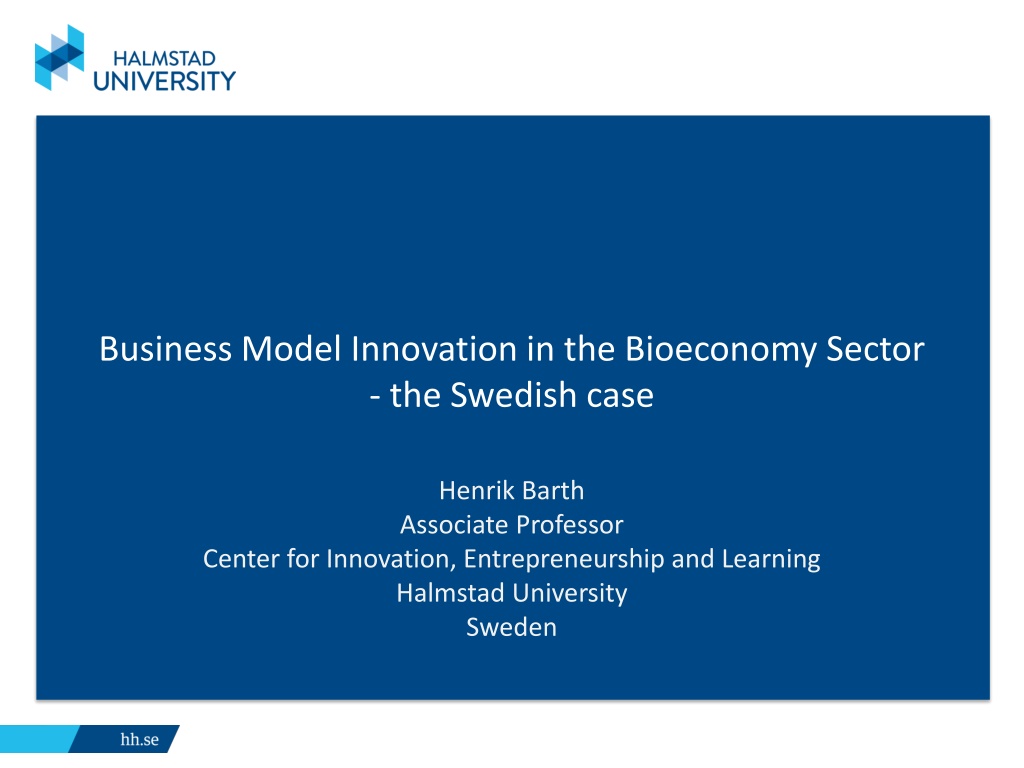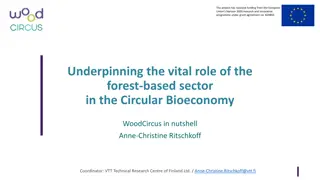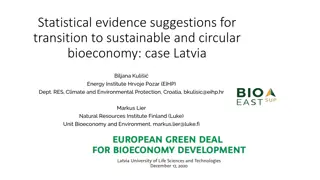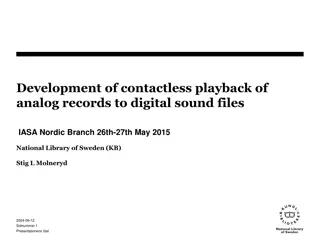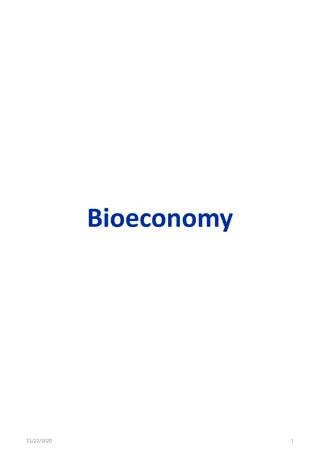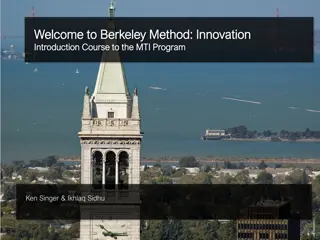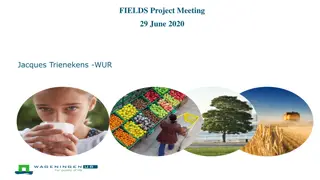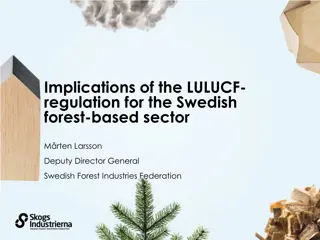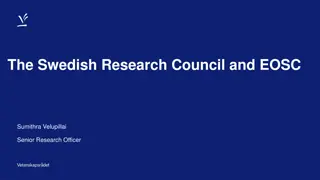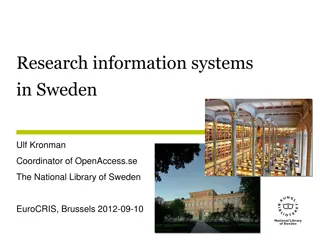Business Model Innovation in the Bioeconomy Sector: Insights from Sweden
Business model innovation is crucial for competitiveness and growth, particularly in the bioeconomy sector. This study focuses on the Swedish case, emphasizing long-term viability, environmental sustainability, policy implications, and feasibility. The literature review highlights the importance of sustainable business models and value creation.
Download Presentation

Please find below an Image/Link to download the presentation.
The content on the website is provided AS IS for your information and personal use only. It may not be sold, licensed, or shared on other websites without obtaining consent from the author. Download presentation by click this link. If you encounter any issues during the download, it is possible that the publisher has removed the file from their server.
E N D
Presentation Transcript
Business Model Innovation in the Bioeconomy Sector - the Swedish case Henrik Barth Associate Professor Center for Innovation, Entrepreneurship and Learning Halmstad University Sweden
Background Business models and business model innovation are seen as a key to companies competitiveness, renewal and growth (Teece, 2010; Foss & Saebi, 2017). However, empirical research on the business models is predominantly European-based in the sectors of media, information technology and biotechnology. research on business in the biomass area have gained limited attention
Most cited articles on BM and Biomass Impact factor of the journal No of citations (Scopus citations) Authors Year Title Journal Title C. K. Prahalad Di Benedetto, C. Anthony Nakata, Cheryl C. Journal of Product Innovation Management 2012 Bottom of the pyramid as a source of breakthrough innovations 4,305 224 Tom L. Richard 2010 Challenges in Scaling Up Biofuels Infrastructure Science 41,063 203 PeterAsmus 2010 Microgrids, Virtual Power Plants and Our Distributed Energy Future The Electricity Journal 0,89 184 Mansoornejad, B. Chambost, V. Stuart, P. Integrating product portfolio design and supply chain design for the forest biorefinery 2010 Computers and Chemical Engineering 3,334 73 Wesley Foell Shonali Pachauri Daniel Spreng Hisham Zerriffi 2011 Household cooking fuels and technologies in developing economies Energy Policy 4,88 64 Gireesh Shrimali Xander Slaski Mark C. Thurber Hisham Zerriffi 2011 Improved stoves in India: A study of sustainable business models Energy Policy 4,88 57 Xu, Dongmei Hao Liu 2018 Carbon Sequestration Capacity of The Forest Chemical Engineering Transactions 0,76 53 Pantaleo, A. Candelise, C. Bauen, A. Shah, N. ESCO business models for biomass heating and CHP: Profitability of ESCO operations in Italy and key factors assessment Renewable and Sustainable Energy Reviews 2014 10,556 52 AntoniosD.Livieratosa PanagiotisLepeniotisb Corporate venture capital programs of European electric utilities: Motives, trends, strategies and challenges 2017 The Electricity Journal 0,819 49 Sari H m l inen Annukka N yh Hanna-Leena Pesonen 2011 Forest biorefineries A business opportunity for the Finnish forest cluster Journal of Cleaner Production 6,395 49
Main Areas of Discussion Long-term Viability Environmental sustainability Policy Process Feasibility
Literature review Major focus on value capture of BM, such as cost structure, feasibility and revenue streams, which is a necessity in the short run but from a strategic perspective attention also need to adress value intention, value proposition, and value creation and delivery (Barth et al, 2017; 2018; 2021). Sustainability aspects are provided in several cases, but few address (or connect to) framework on Sustainable BM (for example, Bocken et al, 2014) or use checklists/tools/methods for sustainable innovation (for example, Prahalad, 2012; Ants et al, 2021)
Unbalanced Business model canvas? Internal factors External factors Cost focus Customer focus Value capture Value creation Exploitation Exploration
The transformation - making the movement towards scalable business models and solutions Innovation Sandbox (Prahalad, 2012)
The Swedish case Telephone survey to all Swedish full- time agricultural entrepreneurs with at least an annual company turnover of 1 million SEK (app. 100.000 Euro) Total no. of firms 1003 (25%) Response rate 312 (31%) East Sweden South Sweden 2597 (64%) 719 (28%) North Sweden 464 (11%) 112 (24%) Total 4064 (100%) 1143 (28%)
Rurality as a driver for sustainable solution? North Sweden reports a more prominent organizational innovation component than both east and south Sweden, addressing two components: Repurpose for society/environment Develop scale up solutions North Sweden has a harsh climate and long distances, which probably foster close integration between the firm and local communities and other stakeholder group The agri-entrepreneurs of north Sweden are more likely to develop sustainable solutions to maximise benefits for society and the environment based on collaborative approaches regarding sourcing, funding, and lobbying and open innovation Source: Barth, H., Ulvenblad, P., Ulvenblad, P-O and Hoveskog, M. (2021). Unpacking Sustainable Business Models in the Swedish Agricultural Sector The Challenges of Technological, Social and Organisational Innovation. Journal of Cleaner Production, Volume 304.
Innovative solutions identified The value chain A crucial challenge for Wapn , as for other food companies, is the food value chain Nowadays, Wapn is closer to the end customer and has built a well-known brand. (Case Wapn ) The company handles the entire chain of biofuel from cultivation of raw material to production of fuel and use. (Case Energifabriken) Differentiation sustainability-focus as a possibility to build value for customers, and not as a constraining barrier. ( Case Wapn )
Summary Identified (major) barriers Regulations and laws, Lack of finance, and lack of markets and potential solutions Overall: Develop Self-contained strategy sustainable BM circular economy Develop your network partners, suppliers and end-users Individual level: Change your mind-set from producer to entrepreneur Firm level: from cost strategy to differentiated strategy Develop skills in the growth phase from technology expert/ innovator (only) to integration of technology, business and sustainability skills From traditional to differentiated value chain branding your product/service shortening the value chain with digital tech?
Thank you for your attention! There are those that look at things the way they are, and ask -why? I dream of things that never were, and ask -why not? George Bernard Shaw
